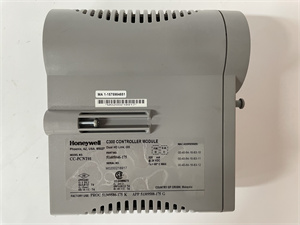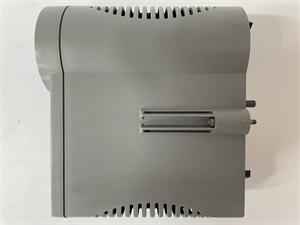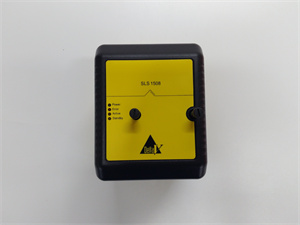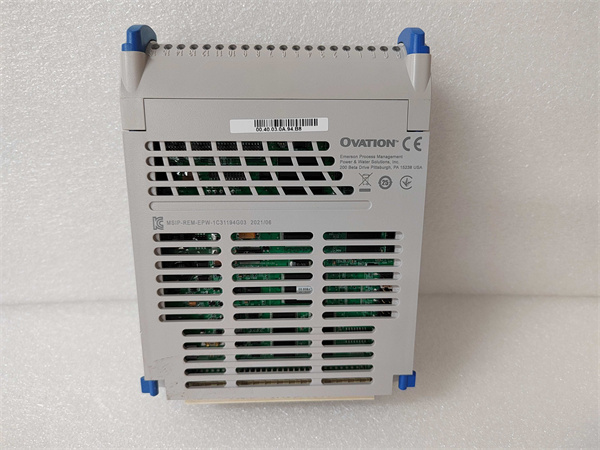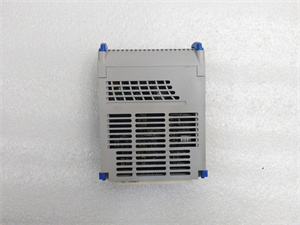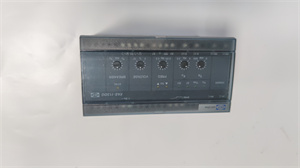Description
Detailed parameter table
|
Parameter name
|
Parameter value
|
|
Product model
|
CC – PCNT01
|
|
Manufacturer
|
Honeywell
|
|
Product category
|
Controller Module
|
|
Input voltage
|
24VDC
|
|
Output voltage
|
24VDC (adjustable)
|
|
Output power
|
360W
|
|
Input voltage range
|
100 – 240VAC
|
|
Maximum output current
|
15A
|
|
Working temperature range
|
– 25°C to 70°C
|
|
Storage temperature range
|
– 40°C to 85°C
|
|
Dimensions (L×W×H)
|
115mm×48mm×150mm
|
|
Weight
|
Approximately 1.2kg
|
|
Communication interfaces
|
RS485, CAN, Ethernet
|
|
Programmable languages
|
C/C++, Modbus, etc.
|
|
Digital inputs
|
8
|
|
Analog inputs
|
4
|
|
Digital outputs
|
4
|
|
Analog outputs
|
2
|
|
Shell material
|
Aluminum or stainless steel
|
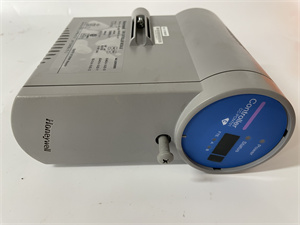
Honeywell CC-PCNT01
Product introduction
The Honeywell CC – PCNT01 is a high – performance controller module, playing a pivotal role in industrial automation systems. As an integral part of Honeywell’s advanced product portfolio, the CC – PCNT01 is engineered to meet the complex demands of modern industrial control.
This module serves as the brain of the control system. It collects data from various sensors and field devices through its multiple input channels, including digital and analog inputs. The high – speed processing capabilities of the CC – PCNT01 enable it to quickly analyze this data. Based on pre – programmed algorithms and control strategies, it then generates appropriate control signals and outputs them through its digital and analog output channels to actuators and other control equipment. In an industrial production line, for example, the CC – PCNT01 can precisely control the speed of motors, the opening degree of valves, and the operation sequence of machinery, ensuring the smooth progress of the production process. It is also a key component in the Experion system, acting as a distributed process controller and I/O gateway, facilitating seamless communication between different parts of the automation infrastructure.
Core advantages and technical highlights
High – speed data processing
The Honeywell CC – PCNT01 is equipped with a powerful processor that enables high – speed data processing. It can handle large amounts of data in real – time, ensuring that control decisions are made promptly. In fast – paced industrial processes, such as high – speed manufacturing lines or power generation plants where rapid changes in process variables occur, the CC – PCNT01 can quickly respond to sensor data, adjust control parameters, and maintain stable operation. This high – speed processing capability significantly improves the efficiency and productivity of industrial systems.
Multiple communication interfaces
Featuring a variety of communication interfaces like RS485, CAN, and Ethernet, the CC – PCNT01 offers excellent connectivity. It can easily communicate with different types of field devices, other controllers, and monitoring systems. In a large – scale industrial complex with a diverse range of equipment from multiple manufacturers, the CC – PCNT01 can establish seamless communication links, integrating all components into a unified control network. For instance, it can communicate with intelligent sensors via RS485, exchange data with other controllers over Ethernet, and control CAN – based actuators, making it highly adaptable to complex industrial communication scenarios.
High – reliability design
Designed with reliability in mind, the CC – PCNT01 has a rugged construction with an aluminum or stainless – steel shell, which can withstand harsh industrial environments. It can resist dust, moisture, vibration, and electromagnetic interference. With a wide operating temperature range from – 25°C to 70°C, it can function reliably in extreme cold or hot industrial settings, such as outdoor oil and gas fields or high – temperature steel – making workshops. Additionally, its power supply system is designed to be stable, ensuring continuous operation even under fluctuating input voltages within the specified range.
Programmable flexibility
The CC – PCNT01 supports multiple programming languages, including C/C++ and Modbus. This programmability allows engineers to customize the control logic according to specific industrial application requirements. Whether it is a simple control task in a small – scale production line or a complex control strategy in a large – scale chemical plant, the CC – PCNT01 can be programmed to meet the needs. Users can write their own control algorithms in C/C++ to achieve highly customized control functions, or use the Modbus protocol for standard – based communication and control, providing great flexibility in industrial automation projects.
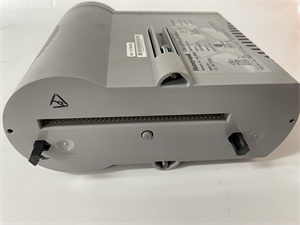
Honeywell CC-PCNT01
Typical application scenarios
Manufacturing industry
In manufacturing plants, the Honeywell CC – PCNT01 is widely used. In an automotive assembly line, it can control the movement of robotic arms, ensuring accurate and efficient parts assembly. By precisely controlling the speed and position of motors, it improves the production accuracy and reduces assembly errors. In a food and beverage production line, the CC – PCNT01 can regulate the filling volume of liquid products, control the packaging machinery’s operation, and monitor the quality – related parameters such as temperature and pressure during the production process. This helps to maintain product quality consistency and increase production efficiency.
Energy industry
In the energy sector, the CC – PCNT01 is crucial. In oil and gas production, it can monitor and control various parameters such as wellhead pressure, oil and gas flow rate, and pump operation. It enables real – time adjustment of production processes to optimize resource extraction and ensure safe and stable production. In power generation plants, whether thermal, hydro, or wind, the CC – PCNT01 can control the operation of generators, turbines, and power distribution equipment. It adjusts the power generation output according to the grid’s demand, maintaining grid stability and power quality.
Chemical industry
For the chemical industry, the CC – PCNT01 plays a vital role. In chemical reaction processes, it can accurately control parameters like temperature, pressure, and raw material flow rate. For example, in a petrochemical plant’s cracking reaction, the CC – PCNT01 ensures that the reaction occurs under the optimal conditions by precisely controlling the heating and cooling systems, as well as the feed rate of raw materials. This not only improves the reaction efficiency but also reduces the generation of by – products and potential safety hazards. In chemical product packaging, it can control the packaging equipment to ensure accurate filling and sealing, maintaining product quality during storage and transportation.
Environmental protection and water treatment
In environmental protection and water treatment facilities, the CC – PCNT01 is also in great demand. In wastewater treatment plants, it can monitor and control the water treatment process, including the operation of pumps, aerators, and water quality sensors. By adjusting the treatment process in real – time according to the water quality data, it ensures that the treated water meets the discharge standards. In air pollution control systems, it can control the operation of dust collectors, scrubbers, and other equipment, reducing pollutant emissions and protecting the environment.
Related model recommendations
CC – PCNT02
The CC – PCNT02 is likely an upgraded version of the CC – PCNT01. It may offer enhanced processing power, more memory, or additional communication capabilities. This model is suitable for applications with higher – level requirements for data processing speed and communication complexity, such as large – scale industrial complexes with a high density of control devices and complex control algorithms.
CC – TCNT01
The CC – TCNT01 might be a module with a different focus, perhaps more specialized in time – critical control tasks or having a different set of input/output configurations. It can be used in applications where precise timing control is crucial, such as in high – speed production lines with strict cycle time requirements.
CC – PAIM01
The CC – PAIM01 is an analog input module. It complements the CC – PCNT01 as it is responsible for collecting analog signals from field sensors (such as temperature, pressure, and flow sensors) and converting them into digital signals for the CC – PCNT01 to process. In an industrial automation system, they work together to form a complete data acquisition and control loop.
CC – PDOB01
As a digital output module, the CC – PDOB01 is used to output digital control signals to actuators and other devices. It pairs well with the CC – PCNT01, which determines the control logic and sends commands to the CC – PDOB01 for execution. In an automated warehouse system, the CC – PCNT01 can calculate the optimal operation sequence, and the CC – PDOB01 can control the opening and closing of electromagnetic valves, motors, and other equipment according to these commands.
CC – PCF901
The CC – PCF901 is a fieldbus communication interface module. It can expand the communication capabilities of the CC – PCNT01 by enabling communication with field devices using specific fieldbus protocols. In a large – scale industrial network where multiple field devices need to be integrated, the CC – PCF901 can work with the CC – PCNT01 to ensure seamless data exchange between the control system and the field devices.
Installation, commissioning and maintenance instructions
Installation preparation
Before installing the Honeywell CC – PCNT01 module, ensure the installation environment meets the requirements. The temperature should be within the range of – 25°C to 70°C, and the humidity should be within the normal range. Prepare the necessary installation tools, such as screwdrivers for mounting the module on the DIN rail and wire strippers for cable connection. Disconnect all power sources in the control system to avoid electrical accidents during installation. Check the module’s appearance for any damage or deformation, and verify that the input voltage at the installation site is within the specified range of 100 – 240VAC. Mount the CC – PCNT01 on a suitable DIN rail in the control cabinet, making sure it is firmly fixed. Prepare the communication and power cables according to the specified specifications, ensuring proper shielding to reduce electromagnetic interference.
Maintenance suggestions
Regularly inspect the CC – PCNT01 module for physical damage, such as cracks in the shell or loose connections. Monitor the module’s operating temperature during normal operation to ensure it remains within the specified range. Use diagnostic tools provided by Honeywell to check the communication status and data processing performance of the module. In case of communication failures or abnormal control behavior, first check the power supply, cable connections, and communication settings. If the problem persists, refer to the detailed troubleshooting guide in the product manual. When replacing components, always use genuine Honeywell parts to maintain the module’s performance and reliability. Keep records of all maintenance activities, including inspection dates, problems found, and solutions implemented, for future reference.
Service and guarantee commitment
Honeywell provides a comprehensive service and guarantee for the CC – PCNT01 module. The product typically comes with a standard warranty period, during which any manufacturing defects will be repaired or replaced free of charge. Honeywell’s global technical support team is available 24/7 to provide assistance for installation, commissioning, and troubleshooting. Whether it’s a query about programming, communication issues, or hardware failures, customers can expect prompt and accurate solutions. Additionally, Honeywell is committed to continuous product improvement and may offer software updates and firmware upgrades for the CC – PCNT01 over time. These updates can enhance the module’s performance, add new features, and ensure compatibility with the latest industrial standards, demonstrating Honeywell’s confidence in the quality of the CC – PCNT01 and its dedication to meeting the long – term needs of customers in the industrial automation field.


